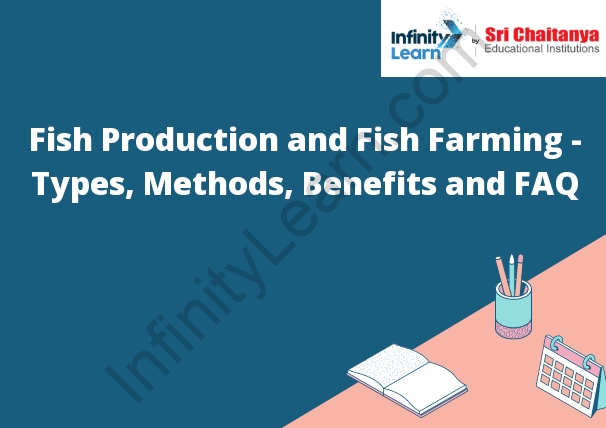Table of Contents
Introduction of Fish Production Fish Farming
is the practice of raising fish in a controlled environment. The main types of fish farming are:
1. Freshwater fish farming, which includes raising fish such as catfish, tilapia, and bass in fresh water ponds, tanks, and raceways.
2. Marine fish farming, which includes raising fish such as salmon and tuna in salt water pens, tanks, and cages.
3. Brackish water fish farming, which includes raising fish such as shrimp and prawns in brackish water (water with a mix of fresh and salt water) ponds, tanks, and raceways.
Fish farming is a rapidly growing industry that is currently providing food for a growing world population. In addition, fish farming is providing jobs and economic development in rural and coastal communities around the world.

Types of Pisciculture
There are many types of pisciculture, but the most common are pond, cage, and rack culture.
- Pond culture is the oldest and most traditional form of pisciculture. It involves the raising of fish in man-made ponds. The ponds are stocked with fish fry or fingerlings, and the fish are allowed to grow to maturity before being harvested.
- Cage culture is a newer form of pisciculture that involves the raising of fish in cages suspended in a body of water. The cages are stocked with fish fry or fingerlings, and the fish are allowed to grow to maturity before being harvested.
- Rack culture is a newer form of pisciculture that involves the raising of fish in racks that are submerged in a body of water. The racks are stocked with fish fry or fingerlings, and the fish are allowed to grow to maturity before being harvested.
Fish Farming Methods
Fish farming is the process of breeding and raising fish in a controlled environment such as a pond, tank or cage. There are a number of different fish farming methods, each with its own advantages and disadvantages.
One common method is to raise fish in ponds. This can be done in two ways: by growing the fish in cages that are placed in the pond, or by allowing the fish to swim free in the pond. The latter method is known as “extensive farming” and is less common than the former.
Another common method is to raise fish in tanks. This can be done in two ways: by growing the fish in tanks that are placed on land, or by growing the fish in tanks that are placed in the ocean. The latter method is known as “mariculture” and is more common than the former.
A third common method is to raise fish in cages that are placed in the ocean. This is known as “aquaculture” and is the most common method of fish farming.
What is Fish Production?
Fish production is the process of raising fish commercially in tanks or enclosures, usually for food. Fish production can be done in fresh water or salt water.
Benefits of Fish Farming
There are many benefits to fish farming. The most obvious benefit is that it provides a sustainable source of food. Fish are a healthy source of protein, and they also contain omega-3 fatty acids, which are beneficial for human health. Fish farming also helps to conserve wild fish populations. It allows farmers to raise fish in a controlled environment, which helps to ensure that the fish are healthy and free of contaminants. Fish farming also helps to create jobs and boost the economy in rural areas.
Communicating Eggs from a Female Rainbow Trout
When a female rainbow trout lays eggs, the male rainbow trout will fertilize the eggs. The eggs will then be released from the female’s body and will drift in the water until they hatch. The baby rainbow trout will then eat plankton until they are big enough to start eating other things.
Controlling Roes Physically
Controlling roes physically involves handling them in a way that keeps them calm and limits their movement. This can be done by using a net to catch the roe, or by gently scooping them up with a shovel or your hands. Once you have them in hand, you can then move them to their new home.
Fish Ranches
A fish ranch is a facility where fish are grown commercially. Fish are usually raised in net pens in the ocean, but they can also be raised in tanks on land.
Confine Framework
The Confine Framework is a Java-based security framework that provides a comprehensive approach to securing Java applications. It enables developers to easily create secure applications by providing a declarative security model that defines how the application interacts with the underlying security infrastructure.
The Confine Framework is composed of the following core components:
Confine Core : Provides the basic security functionality required to secure an application.
: Provides the basic security functionality required to secure an application. Confine Security Manager : Enables developers to easily configure the security properties of their applications.
: Enables developers to easily configure the security properties of their applications. Confine Security Model: Defines how the security properties of an application are enforced.
The Confine Framework also includes a number of supporting components that are used to provide additional security functionality:
Confine Enforcer : Enforces the security policies defined by the Confine Security Model.
: Enforces the security policies defined by the Confine Security Model. Confine Authentication Provider : Provides authentication services for the application.
: Provides authentication services for the application. Confine Authorization Provider: Provides authorization services for the application.
The Confine Framework is open source software released under the GPL license. It is available for download from the SourceForge website:
http://sourceforge.net/projects/confine/
Copper-Composite Nets
copper-composite nets are nets made of copper and other materials.
Copper-composite nets are used in a variety of applications, including:
-Electronics
-Telecommunications
-Aerospace
-Shipbuilding
-Automotive
-Medical Devices
-Others
Open Net Pen Framework
Open Net Pen Framework is a free and open source software framework for developing applications in C++. It provides a modular architecture and a comprehensive set of libraries and tools to help developers create network-aware applications.
Open Net Pen Framework is released under the GNU General Public License.
Open Net Pen Framework is developed by NetPen Development Team.
Negative Outside Impacts
The negative externalities of coal include air pollution, water pollution, and global warming.
Air Pollution
Coal-fired power plants are a major source of air pollution, including sulfur dioxide, nitrogen oxides, and particulate matter. These pollutants can cause respiratory problems, heart disease, and other health problems.
Water Pollution
Coal-fired power plants are also a major source of water pollution. They produce wastewater that contains pollutants such as mercury, arsenic, and lead. These pollutants can contaminate water supplies and harm aquatic life.
Global Warming
Coal is a major source of greenhouse gas emissions, which contribute to global warming.
Water System Trench or Lake Frameworks
The water system trench or lake frameworks are the physical structures that hold and convey the water. They may be made of concrete, metal, or plastic.
Composite Fish Culture
Aquaponics is the combination of hydroponics (cultivating plants in water) with aquaculture (raising fish). In an aquaponics system, the fish waste provides nutrients for the plants, and the plants act as a natural filter, cleaning the water for the fish.
Aquaponics can be used to produce a variety of crops, including vegetables, fruits, and herbs. It can also be used to raise freshwater fish, such as tilapia, catfish, and bass.
There are many different types of aquaponics systems, but all share the same basic components:
Fish tank
Grow bed
Pump
Aquaponics systems can be either open or closed. An open system is one in which the water is constantly being replaced, while a closed system recycles the water.
Closed systems are generally more efficient because they use less water, but they can be more complex to set up and manage.
Incorporated Reusing Frameworks
There are a few popular web development frameworks that are worth considering when starting a project. These frameworks can help speed up development time and ensure a level of consistency across projects.
When deciding whether or not to use a framework, it’s important to consider the project’s requirements and the skills of the development team. If a team is familiar with a certain framework, it might make sense to use it. However, if a team is not familiar with a framework, it might be wise to choose a different option.
Some of the more popular web development frameworks include:
Ruby on Rails
Laravel
Symfony
Django
Node.js
AngularJS
ReactJS








